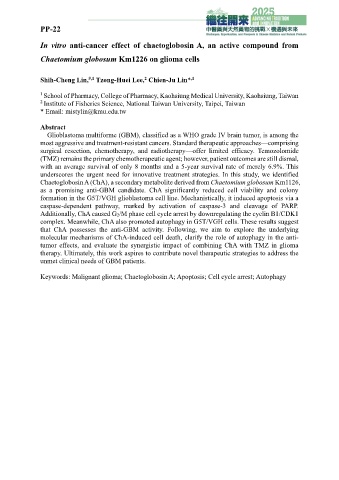Page 204 - 2025中醫藥與天然藥物聯合學術研討會-中醫藥與天然藥物的挑戰X機遇與未來大會手冊
P. 204
PP-22
In vitro anti-cancer effect of chaetoglobosin A, an active compound from
Chaetomium globosum Km1226 on glioma cells
2
#,1
,1
Shih-Cheng Lin, Tzong-Huei Lee, Chien-Ju Lin*
1 School of Pharmacy, College of Pharmacy, Kaohsiung Medical University, Kaohsiung, Taiwan
2 Institute of Fisheries Science, National Taiwan University, Taipei, Taiwan
* Email: mistylin@kmu.edu.tw
Abstract
Glioblastoma multiforme (GBM), classified as a WHO grade IV brain tumor, is among the
most aggressive and treatment-resistant cancers. Standard therapeutic approaches—comprising
surgical resection, chemotherapy, and radiotherapy—offer limited efficacy. Temozolomide
(TMZ) remains the primary chemotherapeutic agent; however, patient outcomes are still dismal,
with an average survival of only 8 months and a 5-year survival rate of merely 6.9%. This
underscores the urgent need for innovative treatment strategies. In this study, we identified
Chaetoglobosin A (ChA), a secondary metabolite derived from Chaetomium globosum Km1126,
as a promising anti-GBM candidate. ChA significantly reduced cell viability and colony
formation in the G5T/VGH glioblastoma cell line. Mechanistically, it induced apoptosis via a
caspase-dependent pathway, marked by activation of caspase-3 and cleavage of PARP.
Additionally, ChA caused G2/M phase cell cycle arrest by downregulating the cyclin B1/CDK1
complex. Meanwhile, ChA also promoted autophagy in G5T/VGH cells. These results suggest
that ChA possesses the anti-GBM activity. Following, we aim to explore the underlying
molecular mechanisms of ChA-induced cell death, clarify the role of autophagy in the anti-
tumor effects, and evaluate the synergistic impact of combining ChA with TMZ in glioma
therapy. Ultimately, this work aspires to contribute novel therapeutic strategies to address the
unmet clinical needs of GBM patients.
Keywords: Malignant glioma; Chaetoglobosin A; Apoptosis; Cell cycle arrest; Autophagy

